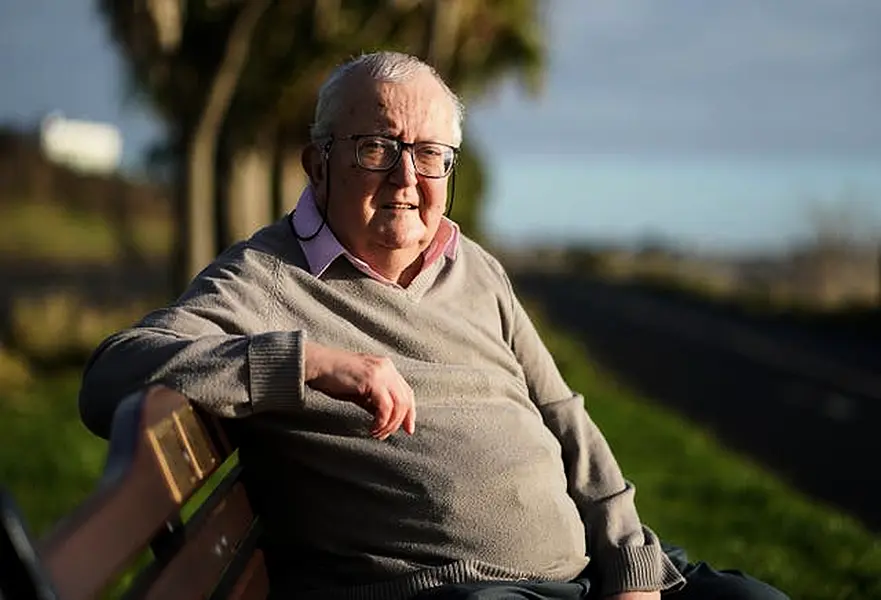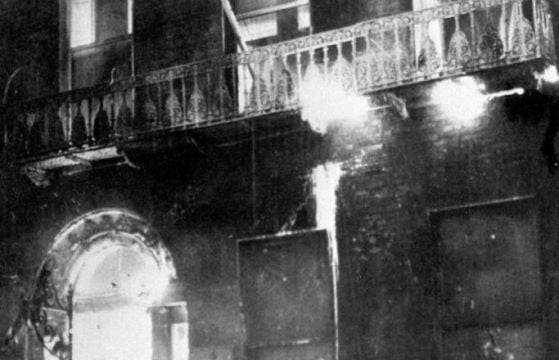Nearly every Dubliner has a story about the day the British Embassy was burnt down in the capital, as the country bristled with anger over Bloody Sunday.
The destruction of the British Embassy, then in the heart of Merrion Square in the centre of Dublin, came days after 13 people were shot dead by paratroopers in Derry.
Another man shot by British soldiers on the day died four months later.

As anger spread beyond Derry and across the island, protesters in Dublin focused on the British Embassy.
Pol O Duibhir was working as a civil servant only a short walk up the street from Merrion Square in the Department of Finance.
He said that the reaction to Bloody Sunday in Ireland was “extreme”.
Mr O Duibhir said: “Dublin was incandescent at that stage.
“People were really boiling over Bloody Sunday.”
Elsewhere, across the country, in the days after the tragedy, workers staged strikes, walkouts and demonstrations.
British businesses were also attacked, while airport workers and dockers downed tools and refused to handle British flights and ships.

The Government had already made clear its own concerns about the events in Derry.
In an address to the nation on the Monday, Taoiseach Jack Lynch had told the Irish people: “The government is satisfied that British soldiers recklessly fired on unarmed civilians in Derry yesterday and that any denial of this continues and increases the provocation offered by present British policies both with the minority in Northern Ireland and to us here.”
But it was not until the Wednesday that huge crowds gathered in the bitter cold and the torrential rain to demonstrate outside the embassy building, which had already been evacuated.
At 4pm, the first petrol bombs were being thrown.
By 7pm, aided by the throwing of more petrol bombs through the smashed windows of the building, the British Embassy was fully alight.
Mr O Duibhir, who says he was not the only civil servant in the crowd that day, remembers it vividly.

He told the PA news agency: “I ended up over at the embassy. I don’t exactly remember how that turned out. That was in the afternoon. And we were aware at that stage that the embassy had been evacuated. So there was no question of anybody being inside being injured.
“It was an absolutely vast crowd.
“I was opposite the embassy about two thirds of the way back. And there was a lot of pressure.
“There were a lot of people shouting and all this sort of stuff.”
Mr O Duibhir remembers seeing a man climbing the railings to smash the windows of the embassy.
He said: “There was a fella climbed up to the balcony of the adjacent building, I think probably there wasn’t railings high enough to jump up on to the embassy building. He got up on to the balcony of the building beside the embassy building and came across on to the embassy balcony.
“He seemed to have, it’s been described as a hatchet elsewhere. I thought it looked more like an ice pick. And he started slamming at the windows.”
He also remembers seeing a “fella with a Molotov cocktail” in the crowd.
The start of the destruction, as witnessed by Mr O Duibhir, had not been the first assault on the British Embassy since the killings on the Sunday.

Historian Dr Brian Hanley told PA: “What people forget is that the embassy was burnt after three days.
“It didn’t happen straight away. What began on the Monday after the massacre was basically walkouts from factories and workplaces across the country.
“And in Shannon and Cork and Waterford and Galway, in Dublin itself and so on, thousands of people simply left work in protest, either for the whole day, or for periods of the day where they marched and held impromptu rallies, and demanded that the government do something.
“In Dublin, the embassy provides the focus so there’s demonstrations on the Monday and it’s attacked on the Monday but it’s not badly damaged.”
Dr Hanley, a lecturer at Trinity College Dublin, believes that Ireland has scarcely seen protests like it since.
He said: “Every town, I would say, and even every village in the Republic of Ireland sees some form of protest over the next three days.
“Every centre of population in the 26 counties sees some form of protest.”
And while the anger was directed towards the British government, this did not mean that the atmosphere was any less febrile.
“It would look from the outside that the state was shaking because you’ve got this scale of activity,” said Dr Hanley.
Such a fear was certainly alive in government and political circles at the time.
Writing in his memoirs, former taoiseach Garret FitzGerald recalled his fears that the killings in Derry “could endanger peace in the island as a whole”.
A Fine Gael TD at the time, he remembered thinking after the burning of the embassy that his own “forebodings about the impact of the Derry massacre on security in the Republic as a whole seemed justified”.
Fifty years later, Mr O Duibhir has some regrets.
He said: “I went home and if I’d have realised it was going to go up so soon I’d have stayed.
“I went home, I just got tired. By the time I got home the reports were coming through on the radio and the television that it had gone up in flames, and I started kicking myself that I didn’t stay around.
“I was unequivocally on the nationalist side. I wasn’t involved militarily or anything, but unequivocally on the nationalist side.
“And I take pride in the burning down of the embassy, frankly, and brought some of my British friends subsequently across to see the site.”







